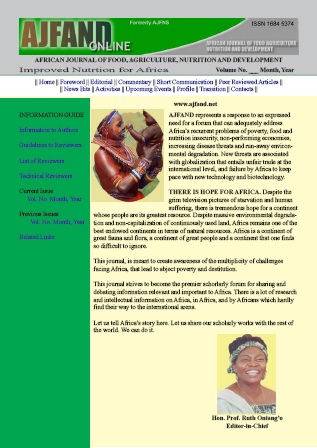
|
African Journal of Food, Agriculture, Nutrition and Development
Rural Outreach Program
ISSN: 1684-5358
EISSN: 1684-5358
Vol. 16, No. 1, 2016, pp. 10666-10681
|
 Bioline Code: nd16014
Bioline Code: nd16014
Full paper language: English
Document type: Research Article
Document available free of charge
|
|
|
African Journal of Food, Agriculture, Nutrition and Development, Vol. 16, No. 1, 2016, pp. 10666-10681
| en |
A PRELIMINARY SURVEY OF ANIMAL HANDLING AND CULTURAL SLAUGHTER PRACTICES AMONG KENYAN COMMUNITIES: POTENTIAL INFLUENCE ON MEAT QUALITY
Lokuruka, Michael N. I.
Abstract
Kenya is composed of over 40 ethnic communities who practice varied methods of animal handling and slaughter. Socio-cultural and religious traditions have the potential to influence animal handling and slaughter practices. These influences have, however, not been documented in the literature as far as the author is aware. Also, the literature has documented the connection between the manner of animal treatment and meat quality, but this is rarely discussed in the literature in Kenya; this connection is important as it informs modern meat trade practices by Kenyans as they trade in the global arena. This survey aimed to mainly establish and document the animal slaughter practices among Kenyan communities, and, to also highlight any current provisions related to meeting modern animal welfare requirements, animal handling procedures in the meat trade and discuss their potential influence on meat quality available in commerce in Kenya. This preliminary study surveyed the slaughter practices among 10 different Kenyan communities through a semi-structured questionnaire, focus group discussions and individual interviews. The survey demonstrated that different Kenyan communities practice varied methods of animal slaughter depending on whether the animal being slaughtered is for public feasting, domestic consumption or commercial merchandizing. The Kenyan communities surveyed in this study depend mainly on males to slaughter livestock for females preparing it for domestic use using a number of instruments and methods. For small stock for domestic consumption, females may slaughter the animal except for Muslims whose males have to slaughter the animal with a special knife (a Khalef) according to Muslim rites to render it Halal. Large stock is invariably slaughtered by males irrespective of the community, and the manner of use of the carcass. Gender, age, religion, community and the size of the animal were the major determinants of the method of animal slaughter. The animal welfare issues highlighted in the survey and related to the handling and slaughter of livestock have important implications for meat quality during commercial merchandizing. There is an apparent need to provide education to herders, livestock handlers, employees and management in the livestock industry in Kenya on the relationship between animal welfare requirements, animal handling procedures and meat quality. Such awareness can potentially improve the quality and economic value of the meat available in commerce.
Keywords
Kenya; animal welfare; handling; slaughter practices; meat quality
|
| |
© Copyright 2016 - African Journal of Food, Agriculture, Nutrition and Development
Alternative site location: http://www.ajfand.net/
|
|
